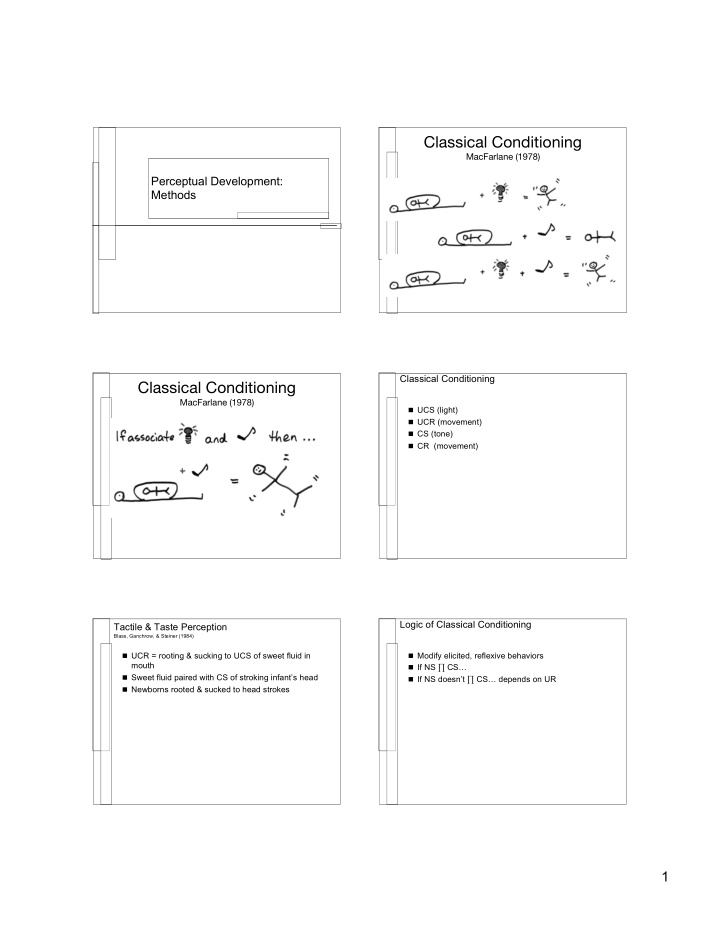



Classical Conditioning MacFarlane (1978) Perceptual Development: Methods Classical Conditioning Classical Conditioning MacFarlane (1978) UCS (light) UCR (movement) CS (tone) CR (movement) Logic of Classical Conditioning Tactile & Taste Perception Blass, Ganchrow, & Steiner (1984) UCR = rooting & sucking to UCS of sweet fluid in Modify elicited, reflexive behaviors mouth If NS ∏ CS… Sweet fluid paired with CS of stroking infant’s head If NS doesn’t ∏ CS… depends on UR Newborns rooted & sucked to head strokes 1
Operant Conditioning: Operant Conditioning: DeCasper & Spence (1986) DeCasper & Spence (1986) Contingent (conjugate) reinforcement = Non-nutritive nipple sucking Pregnant moms read Dr. Seuss Read new vs. old story after birth Short IBIs Long IBIs Logic of Operant Conditioning Modify emitted, intentional responses If frequency changes, infer sensitive to reinforcer, cared about consequences, paired emitted behavior with reinforcer If frequency doesn’t change… no answers String pulling video Sullivan & Lewis, 2003 Experimental methods: Psychophysiological Measure the relationship between behaviour and physiological processes Autonomic system changes: Heart rate, skin conductance 2
Experimental methods: Psychophysiological Measure the relationship between behaviour and physiological processes Autonomic system changes: Heart rate, skin conductance Brain activity: EEG - electroencephalography (and ERP - event-related potentials) http://users.umassmed.edu/teresa.mitchell/forparents.html Novelty detection Experimental methods: Psychophysiological Object processing Visual motion Measure the relationship between behavior and Mirror neurons physiological processes Face/Eye gaze processing Speech sound perception Autonomic system changes: Voice “recognition” Heart rate, skin conductance Word processing in biL Brain activity: Cross-modal integration EEG electroencephalography (and ERP event-related Atypical development potentials) fMRI functional magnetic resonance imaging Dehaene-Lambertz & Dehaene, 1994 Experimental methods: Psychophysiological Speech perception Measure the relationship between behavior and Language processing physiological processes Clinical uses Autonomic system changes: Adolescence Heart rate, skin conductance Brain activity: EEG electroencephalography (and ERP event-related potentials) fMRI functional magnetic resonance imaging NIRS Optical tomography http://www.mch.com/clinical/radiology/fmri/Clinicaluses.html 3
Imaging sound perception in infants - OT Experimental methods: Psychophysiological Measure the relationship between behavior and physiological processes Autonomic system changes: Heart rate, skin conductance Brain activity: EEG electroencephalography (and ERP event-related potentials) fMRI functional magnetic resonance imaging NIRS Optical tomography MEG magnetoencephalography Peña et al., 2003 http://infantstudies.psych.ubc.ca/meth_nirs.html http://www.spectroscopynow.com/FCKeditor/UserFiles/Image/spectroscopyNOW_ezines_2005/SN/SN14a/SN14a_I_baby.jpg Developmental Speech Perception: Behavioural and Neural Insights Perceptual Development Yukkurihanashitekudasai Yukkuri hanashi te kudasai please speak-you slowly 4
Early speech perception & production Speech perception mental processes that allow us to recognize, select, organize, and interpret the sounds of spoken language Why is speech perception interesting? What are the main questions in speech perception research? What are the units of perception? What is the percept? (which processes are “perceptual”?) How are rules represented? What is special about speech? Kuhl, 2004 Some Topics Perceiving speech versus other sounds Distinguishing between speech sounds: Universal beginnings Tuning in infancy Use of speech sounds when learning words Segmenting units from continuous speech Speech perception and actions Early perceptual biases Newborns prefer to listen to their mother’s voice And so do fetuses… DeCasper & Fifer, 1980 Kisilevsky et al., 2003 5
Early perceptual biases Early perceptual biases Newborns prefer to listen to their own language Newborns prefer to listen to speech Mehler et al., 1988 Vouloumanos & Werker, 2007 Imaging speech perception in infants - fMRI Dehaene-Lambertz, Dehaene, & Hertz-Pannier, 2002 Dehaene-Lambertz, Dehaene, & Hertz-Pannier, 2002 Information flow during speech processing Dehaene-Lambertz et al., 2006 Dehaene-Lambertz, Dehaene, & Hertz-Pannier, 2002 6
Imaging sound perception in infants - OT • LH over helmet in adult occipital region • Continuous head position monitoring Peña et al., 2003 Ka video Perception of speech sounds Perception of speech sounds 80 7
English stop consonants English stop consonants Hindi stop consonants Perception of speech sounds: Conditioned head-turn procedure Language-specific speech tuning Roles of Experience (Gottlieb, 1976; Modified by Aslin & Pisoni, 1981) 8
Koba! Target Actor1 can no longer reach objects with A. Martin, K. Onishi Non-target Principle #1: Sensitivity vs. Perception Sensitivity (discrimination) is not equivalent to perceptual understanding Five principles of perceptual Perception is not equivalent to adaptive responding development Generally, the order of emergence is sensitivity, perceptual understanding, and finally adaptive responding 9
Principle #2: Principle #3: Perceptual-Motor Development Multiple Measures Perception functions to guide action Multiple measures exploit the richness of infants’ behavior Perception & action are linked developmentally Multiple measures confirm, augment, or reinterpret Perception in infants is measured with action; findings from single measures physiological measures must be correlated with action Principle #4: Principle #5: Sampling Intervals Age & Experience Adequate sampling intervals are required to Age is not an independent variable; it is not an characterize developmental change explanatory variable; it is not a grouping variable; age is a stand-in for unknown factors Most developmental research has not sampled adequately to distinguish various trajectories (thus, Experience is typically measured by days since little evidence for or against developmental stages or onset; there is no punctate onset; days-since-onset any other pattern of change) is a stand-in for unknown factors 10
Recommend
More recommend